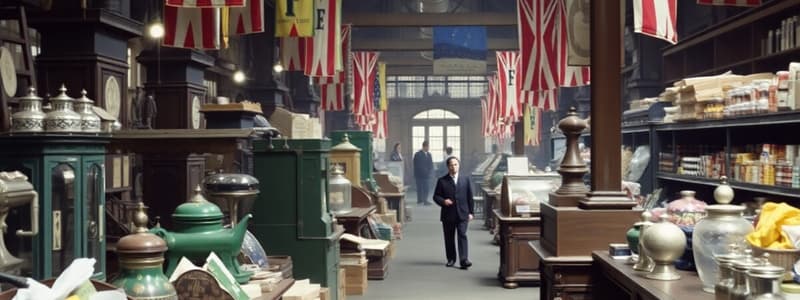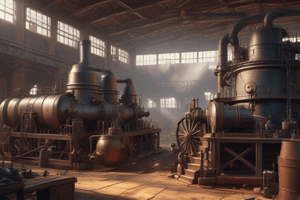Podcast
Questions and Answers
Which of the following inventions was NOT a product of the Second Industrial Revolution?
Which of the following inventions was NOT a product of the Second Industrial Revolution?
- Automobile
- Television (correct)
- Bicycle
- Sewing Machine
Mass consumerism allowed only the wealthy to buy non-essential goods.
Mass consumerism allowed only the wealthy to buy non-essential goods.
False (B)
What new energy source transformed the Second Industrial Revolution?
What new energy source transformed the Second Industrial Revolution?
electricity
The __________ principle, proposed by Joseph Lister, emphasized the importance of sanitation in medical practices.
The __________ principle, proposed by Joseph Lister, emphasized the importance of sanitation in medical practices.
Which of the following best describes the economic divide in Europe during the Second Industrial Revolution?
Which of the following best describes the economic divide in Europe during the Second Industrial Revolution?
Match the following inventors with their primary contributions:
Match the following inventors with their primary contributions:
Sweatshops were primarily found in rural areas during the Second Industrial Revolution.
Sweatshops were primarily found in rural areas during the Second Industrial Revolution.
Who was a prominent reformer that advocated for urban health and sanitation in Britain?
Who was a prominent reformer that advocated for urban health and sanitation in Britain?
Flashcards
Second Industrial Revolution
Second Industrial Revolution
A period of rapid technological advancement that began in the late 19th century, marked by innovations in steelmaking, electricity, and internal combustion engines.
Mass consumerism
Mass consumerism
The mass production and consumption of goods, particularly non-essentials, made possible by industrialization and rising wages.
Two Economic Zones of Europe
Two Economic Zones of Europe
A concept that refers to the spread of factories and industries, leading to economic disparity between regions that industrialized and those that remained largely agrarian.
Sweatshops
Sweatshops
Signup and view all the flashcards
Medical Revolution
Medical Revolution
Signup and view all the flashcards
Anarchism
Anarchism
Signup and view all the flashcards
Contagious Diseases Acts
Contagious Diseases Acts
Signup and view all the flashcards
The Woman Question
The Woman Question
Signup and view all the flashcards
Study Notes
Second Industrial Revolution
- Started in the late 19th century.
- Inventions such as steel, chemicals, fertilizers, weapons, electricity, radio, telephone, internal combustion engines, automobiles, and airplanes.
- Energy transformation from new sources like electric power
- Key inventors include Bessemer, Edison, Marconi, Bell, Daimler, Ford, and Wright brothers.
Mass Consumerism
- Social classes could now afford non-essential goods.
- Department stores sold a variety of goods for different social classes.
- Europe was divided into industrialized and non-industrialized regions during this period.
- The concept of sweatshops and pieceworkers emerged.
- White-collar jobs increased in number and variety.
- Britain had laws related to contagious diseases.
- Anarchism was a significant ideology during this time.
Medical Revolution
- Began in the 19th century.
- New ideas like vaccines, urban sanitation, clean water, pasteurization, and germ theory improved medicine.
- Inventors like Chadwick and Haussmann led the way by creating public health improvements.
- Leading thinkers included those who proposed these ideas, such as those mentioned in the text.
- New medical practices and ideas improved outcomes in health and medicine.
Modern Transportation
- Urban transportation advancements (subways, streetcars, commuter trains) allowed for suburban growth and expansion beyond the city center.
- Social classes had varying lifestyles affected by advancements in transportation.
Social Classes
- Upper, middle, and lower classes are the distinct categories used to analyze the general differences.
- Marriage expectations varied through the social classes.
- Work and employment opportunities were different across the social classes.
- Woman's role and responsibilities were also shaped by social class.
Mass Education
- Universal compulsory elementary education.
- Increase in literacy rates and mass circulation of newspapers.
Mass Leisure and Consumerism
- Increased leisure time due to certain developments
- Increased consumer spending.
- New forms of entertainment surfaced.
- Role of the railroad in the emergence of leisure activities.
Studying That Suits You
Use AI to generate personalized quizzes and flashcards to suit your learning preferences.




